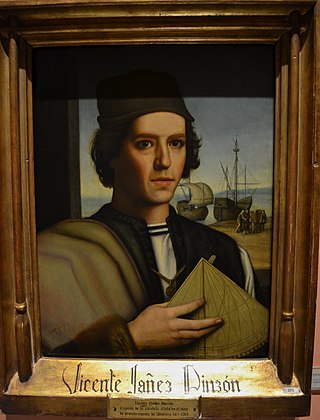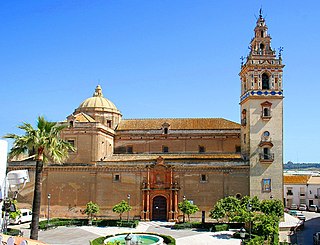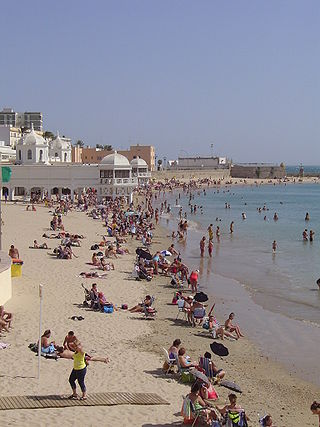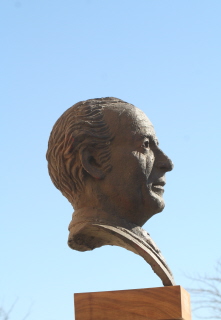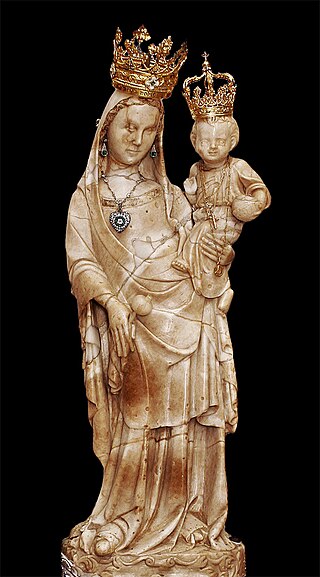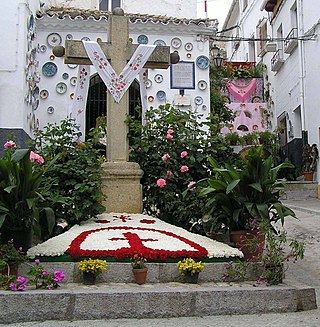Early years

As Pedro Rodríguez, mayor of Huelva, remarked in 1999, the Columbian Festivals are atypical of Andalusia in that they are not rooted in religion. [3]
Although Huelva has had religious festivals at least since the 17th century—a pilgrimage day in the month of September honors the city's patron, the Virgin of La Cinta—toward the end of the 19th century sentiment began to arise for the recognition of the province of Huelva for its role in Columbus's first voyage, and what had come to be known as the Discovery of the Americas. As the celebration of the fourth centenary of the Discovery of the Americas approached, there was an intent to draw attention to the Lugares colombinos , the places in Moguer and Palos de la Frontera associated with the voyage. This movement began around 1880, led by the recently created Real Sociedad Colombina Onubense (Royal Columbian Society of Huelva), [4] who revived a similar idea initially put forward by Civil Governor Mariano Alonso y Castillo in 1855.
The first occurrence of the Columbian Festivals was an immediate success in Huelva and in nearby Palos de la Frontera. Setting the nautical tone, the Captain General of the Maritime Department of Cádiz, Luis Hernández-Pinzón Álvarez, descendant of co-discoverer of the Americas, Martín Alonso Pinzón, attended on August 3. Several vessels of the Spanish Navy were also present. More than 15,000 people gathered at the Monastery of La Rábida in Palos for a "disembarkation" of the Spanish navy and for a fireworks show.
Despite the city already having the festival of La Cinta, the new festivities took root rapidly. In those early years, the festivities included outdoor masses, literary competitions, visits to La Rábida, and traditional sporting competitions. Beginning in 1925, when the Círculo Mercantil set up a booth, there began to be a massive celebration at the city quayside. From this point, the classic elements of an Andalusian fair began to attach themselves to the Columbian Festivals: booths (casetas: some of these are larger structures than is perhaps suggested by the English-language word "booth"), attractions, raffles, and spaces set aside for dancing.
The importance of the festivals in this era can be seen in the descriptions of them in the local press, such as this in 1924:
Every day one notes more animation for these patriotic festivals, that go far beyond the celebrations in earlier years. [5]
And on the special illumination for the festivals:
Incredibly beautiful arches have been placed on the waterfront promenade, as well as on the promenades of Las Palmeras (the Palms) and El Balneario (the Baths), which will provide an unprecedented class of illumination, which has already come to be celebrated in all justice by the general public. [6]
As for the presence of the Spanish Navy:
… it is expected that several warships will have anchored in our waters, to which effect Mister Marchena Colombo, president of the Columbian Society, has received a letter from the general in charge of the Naval department, announcing that the largest number of ships that circumstances permit will come to Huelva. [7]
And on the institutional celebrations of 3 August commemorating Columbus's departure from Palos de la Frontera:
As is customary, on the third, the authorities of Huelva and associates of the Columbian Society will leave for La Rábida, where they will celebrate a mass in commemoration of that heard by Columbus and his intrepid co-voyagers before their departure from the port of Palos. [8]
Growth and crisis of the festivities
Over the years, the Columbian Festivals began to become Huelva's leading celebration, winning out over religious and academic festivals, and became increasingly a festival of entertainment with massive attendance. It outgrew the capacity of its waterfront site and in 1943 moved to a less contained space, the Interior Port of Huelva.
Despite this expansion, and despite continuing to hold the fair in a maritime-related location, the maritime spirit of the festival began to fade, as can be seen in the complaint of then-mayor Francisco Montenegro, expressing openly that in comparison with his youth:
… those festivals that we came to know in our childhood years came closer to our hearts. And it was that they had more flavor of the sea and more emotion in its spiritual and evocative sense. They didn't hang so many fair lanterns on the old quayside promenades, but on the other hand the battleships Reina Regente and Pelayo, together with other warships, filled the streets with white uniforms when the sailors came ashore. [9]
By 1965, the celebrations were displaced a kilometer further south of the city, to what was then known as Avenida Francisco Montenegro, near the present-day Estadio Nuevo Colombino ("New Columbian Stadium"). The structure of the fair was similar today's, although the booths were large permanent constructions, in open air to take advantage of the cool of the August nights. Three years later, the bullfighting arena Plaza Monumental de Toros de Huelva opened adjacent to the fairgrounds; it ended up being demolished in the 1990s. This was a time of economic and demographic growth in the city thanks establishment of a development center (Polo de Desarrollo). Many of the new and growing businesses established their own booths in the fair district. Nonetheless, there was a decline in the late 20th century, and the city government—which needed land for a new football (soccer)—moved the fairgrounds again beginning in the year 2000. That year, a tradition began of dedicating a gate each year to a provincial building or institution.







